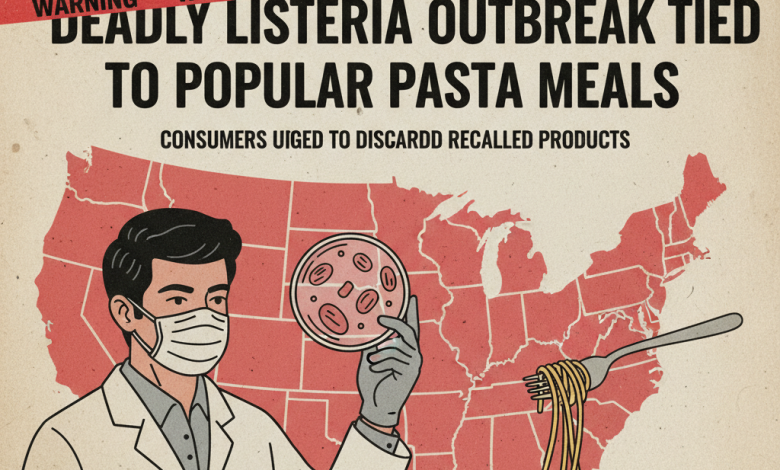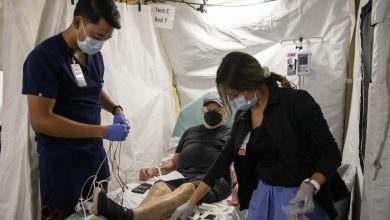15 States on High Alert: Deadly Listeria Outbreak Tied to Popular Pasta Meals

A multistate listeria outbreak tied to widely sold, ready-to-eat pasta meals has public health officials and retailers scrambling — and has left families mourning. The Centers for Disease Control and Prevention (CDC), the U.S. Food and Drug Administration (FDA), and the U.S. Department of Agriculture’s Food Safety and Inspection Service (FSIS) have linked the outbreak to prepackaged pasta dishes sold at major retailers, and have expanded recalls as investigators work to trace the contamination source. As of the latest official updates, the outbreak has caused illnesses in people across 15 states, resulted in dozens of hospitalizations, and is associated with multiple deaths — circumstances that have put 15 States on High Alert.
What happened — the timeline in brief
The outbreak investigation began earlier in the year when public health labs detected matching Listeria monocytogenes bacteria in patients whose illnesses were linked through the CDC’s PulseNet genetic-typing system. That initial signal prompted traceback investigations, product testing by companies and regulators, and a series of recalls. Federal investigators determined that certain prepared pasta meals — notably chicken fettuccine alfredo and meatball marinara-style dishes sold under major retail brands — were likely vehicles for the outbreak. Subsequent testing identified the outbreak strain in samples of pre-cooked pasta used in those products.
Public alerts and recalls initially circulated in June when FreshRealm recalled certain chicken fettuccine alfredo meals. In late September regulators expanded those alerts after additional testing by a supplier found Listeria in linguine used in multiple meal lines, and the FSIS issued a public health alert for Marketside brand ready-to-eat meals sold at Walmart and the FDA posted updates about the supplier’s recall of lots of pre-cooked pasta. The CDC’s case count and geographic spread were updated as the investigation progressed; current official counts show about 20 reported illnesses across 15 states, with many hospitalizations and several deaths.
Which products are implicated — and where they were sold
The investigation has focused on prepared, heat-and-eat or ready-to-eat pasta meals produced or distributed by a small set of manufacturers and sold by large national retailers. The recall notices and FSIS/CDC alerts have specifically mentioned:
- FreshRealm chicken fettuccine alfredo meals sold under Marketside (Walmart) and Home Chef (Kroger) labels that were recalled in June.
- Marketside Linguine with Beef Meatballs & Marinara Sauce (12-oz trays) with certain “best if used by” dates, included in the FSIS public health alert.
- Trader Joe’s Cajun Style Blackened Chicken Fettuccine Alfredo lots covered in the recall expansions.
Labels for affected products may show establishment numbers such as “EST. P-50784,” “EST. P-47770,” or “EST. P-47718” in the USDA mark of inspection; some alerts also list specific best-by dates for consumers to check. If you have these products in your home, public health agencies urge disposal or return to the place of purchase and careful cleaning of any surfaces that touched the food.
The human toll: why this matters
Listeria monocytogenes is a bacterium that can cause listeriosis, a serious infection. While healthy people may experience only mild symptoms, Listeria is especially dangerous for pregnant people, newborns, older adults, and people with weakened immune systems. Complications among those groups can include bloodstream infections, meningitis, pregnancy loss, and death. The current outbreak has led to many hospitalizations and multiple fatalities — facts that prompted the label 15 States on High Alert in public messaging and widespread media coverage.
Official summaries for this outbreak list roughly 20 reported cases, about 19 hospitalizations, and four deaths connected to the strain under investigation. Public health authorities caution that reported numbers may undercount the true scale, because not all infected people seek medical care or have isolates submitted and genetically typed. That’s why investigators combine lab data with patient interviews and product testing to build the complete picture.
Symptoms to watch for — and when to seek care
Listeriosis symptoms usually begin a few days to several weeks after exposure, making it harder to immediately link an illness to a particular food. Common signs include:
- Fever and muscle aches, sometimes preceded by diarrhea or other gastrointestinal symptoms.
- In more severe cases, symptoms such as headache, stiff neck, confusion, loss of balance, and convulsions, which can indicate invasive infection.
- Pregnant people may experience only mild flu-like symptoms, but infection can lead to miscarriage, stillbirth, or severe infection in the newborn.
Anyone who ate recalled or suspect pasta meals and develops fever or other concerning symptoms should seek medical attention and tell the provider about the possible exposure to Listeria. Early diagnosis (blood cultures or spinal fluid testing, when appropriate) and prompt antibiotic treatment can be lifesaving.
What regulators and companies are doing
Federal agencies — notably the CDC, FDA, and FSIS — are coordinating the investigation, combining genetic data from patient isolates, product testing, and supply-chain traceback to identify where contamination likely occurred. The FDA’s outbreak investigation page and FSIS public alerts explain that a supplier’s sample of linguine tested positive for Listeria, prompting supplier recalls and an evaluation of whether additional product lines need to be pulled from distribution.
Retailers named in the alerts, including Walmart and Trader Joe’s, have cooperated with recalls and removed implicated lot numbers from shelves. Some companies have issued public statements emphasizing cooperation with investigators, expanded internal testing, and additional sanitation measures at affected facilities. Independent coverage from news outlets has reported that multiple production establishments and establishment numbers are part of the regulatory record — an expected complexity in large-scale prepared-food supply chains.
How contamination can happen — and why pasta isn’t magically safe
It can be tempting to assume that cooked or dried pasta is inherently safe; after all, many forms of pasta require boiling. But in the prepared meals at issue, pasta is often pre-cooked, cooled, mixed with proteins (like chicken or beef), sauces, and then chilled or frozen for retail sale. Listeria can survive and even grow at refrigeration temperatures — a rare but critical trait that sets it apart from many other pathogens. If an ingredient or processing environment becomes contaminated, the organism can be distributed into finished products. Cross-contamination in facilities, inadequate sanitation, or lapses in temperature control can all contribute.
That means product testing, facility environmental sampling, sanitation practices, and strict temperature management are essential lines of defense. When those defenses fail, the pathogen can reach consumers even in processed or “ready-to-eat” items. The FDA and FSIS routinely investigate and, when necessary, order recalls or issue public health alerts to remove contaminated items and protect public safety.
What consumers should do right now
If you live in one of the affected states or shopped at national retailers recently, follow these steps:
- Check your fridge/freezer: Look for brand names, establishment numbers, and best-by dates listed in the recall/alert notices. If you find an implicated product, do not eat it. Dispose of it or return it to the place of purchase for a refund.
- Clean and sanitize: Clean any surfaces, utensils, or containers that may have touched the recalled product. Use hot, soapy water followed by a household disinfectant according to label instructions. Remember that Listeria can survive in cool, moist niches like drains, slicers, and conveyor belts — common targets of environmental contamination.
- Monitor for symptoms: If you or a household member becomes ill after eating a recalled product — especially if pregnant, elderly, or immunocompromised — contact a healthcare provider immediately and mention the potential Listeria exposure.
- Dispose carefully: If discarding product, place it in a sealed bag in an outdoor trash container to prevent accidental consumption by pets or others.
These are practical steps that reduce risk, prevent further cross-contamination, and ensure that potential cases get medical attention quickly. Public health agencies also maintain recall pages where consumers can check specific lot numbers and product images.
Why the outbreak spread across states
Prepared meals produced centrally and distributed nationally can quickly reach many states, which is why foodborne outbreaks often become multistate events. The implicated products were sold at large retailers with national footprints — increasing the geographic reach of the contamination. In addition, the time lag between exposure and symptoms, variable healthcare-seeking behavior, and the time required for lab confirmation and genetic matching mean outbreaks can take weeks or months to characterize fully. Those factors contribute to the CDC’s framing of the situation as affecting 15 states and to the need for coordinated federal-state response.
Longer-term implications for industry and regulators
High-profile multistate outbreaks accelerate scrutiny of food-supply safety systems. Investigations often reveal gaps in environmental monitoring, sanitation, supplier controls, or recordkeeping. When a supplier’s ingredient tests positive — as with the pre-cooked linguine in this outbreak — it raises questions about upstream controls and supplier-auditing practices. Expect regulators to press for corrective actions, and industry to consider enhanced environmental sampling, improved supplier verification, and investments in technologies (e.g., rapid testing, better facility design) that reduce niches where Listeria can persist.
There may also be legal and reputational consequences for affected manufacturers and retailers. Recalls are costly, and public confidence is easily shaken after an outbreak that causes severe illness and death. Companies often respond with public statements about cooperation with regulators and steps to prevent recurrence; investigators may follow with recommendations or mandatory corrective actions depending on the findings.
How public health surveillance works — and why numbers change
When you see counts like “20 cases across 15 states,” it’s important to know how those numbers are compiled. Public health agencies rely on a combination of clinical reports, laboratory confirmations, genetic sequencing (which links cases to the same outbreak strain), and epidemiologic interviews with patients. Because sequencing and interviews take time, case counts and geographic distribution are updated as new information arrives. CDC and partner agencies routinely warn that early numbers are preliminary and may be revised upward as more cases are identified or linked. That’s one reason authorities emphasize the precautionary principle — issuing recalls and public health alerts before the full scope is known to prevent additional illnesses.
History: listeria outbreaks teach hard lessons
Listeria outbreaks can be devastating and are not new. Past events — from cantaloupe-linked outbreaks to deli-meat incidents — demonstrate how products that seem low-risk can become dangerous when processing or environmental controls fail. The 2011 cantaloupe outbreak and several deli-meat and cheese investigations in prior years led to regulatory and industry changes, but Listeria’s ability to persist in facility niches means continuous vigilance is required. Each outbreak becomes a case study for improving detection, recall speed, and prevention.Two deads in Listeria outbreaks
Final takeaways — what the public needs to know
- The phrase 15 States on High Alert accurately captures the geographic spread and urgency of this outbreak: dozens of hospitalizations and multiple deaths prompted nationwide retail recalls and federal alerts. If you live in or visited any of the affected states recently, check your refrigerator for implicated products.
- Do not eat recalled products. Dispose of them or return them to the store, and disinfect any surfaces that may have contacted the food.
- Pregnant people, older adults, infants, and people with weakened immune systems should be particularly cautious; if you suspect exposure and experience symptoms, seek medical care promptly.
- Expect ongoing updates. Investigations evolve as agencies collect more data, test products, and trace supply chains. Official agency web pages (CDC, FDA, FSIS) provide current lists of recalled products and guidance.




